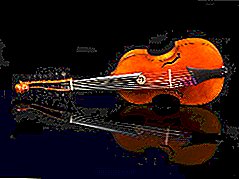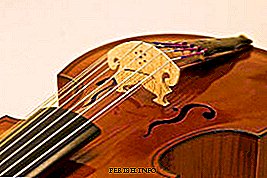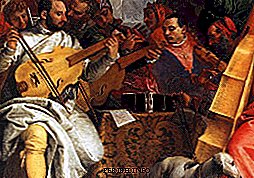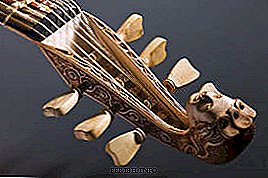Musical instrument: Viola

The old family of stringed stringed instruments with a quiet, gentle sound and poetic name - viola ... They were widespread in the Renaissance: accompanied by church services, delighted the refined hearing of aristocratic families and sounded at all public holidays and festivals.
Outwardly, the violas are very similar to the modern violin group that is well known to us. And this is natural, because the tools are related. But the "relationship" between them "family" can hardly be called. There was a time when viols were considered exquisite musical instruments worthy of secular society, and violins - rude and impudent "rivals" from the streets. Subsequently, the soft and muted timbre of the violas ceased to make a sensitive listener, and he preferred brilliant and juicy violin sounds. This is how the violin not only “turned out” the relatives from the stage, but also sent them into oblivion for a whole century.
Sound
Viola, created for the ecstasy of hearing nobles, had an unusually gentle, velvety and soft sound. Her steady and clear voice with a slight vibrato was the result of the design features of the instrument, its bow and strings. In addition to the main ones, a whole system of resonating strings was installed on the viola, the vibrations of which created a beautiful and delicate sound. The strings were not very tight and constantly required frequent tuning.
An important means of expressiveness in viola is the ability to play the finest sound nuances. Music for the instrument on the dynamic nature was aligned, without sound overload.
Story Viola borrowed from the lute, which tuned into quarts, but with a third in the middle: re, salt, do, mi, la, re.
A photo:




Interesting Facts:
- The cruel and tyrannical king of England Henry VIII was very talented and educated. Being a great music lover, he was very fond of playing the viola. The collection of the king of this instrument at the time of death was 19 magnificent specimens.
- The French "Sun King" Louis XIV - a great connoisseur of various types of art, was very musical. He skillfully knew how to play several musical instruments, including the viola. The viola collection of Louis XIV consisted of 24 instruments.
- The Hungarian prince Esterhazy, who served in the service of the great Austrian composer Joseph Haydn, was fond of playing the baritone gamba. A tool that has not received much distribution. The baritone gamba is remembered only because the composer wrote 126 works for her to please the prince.
- The initiator of the creation of a family of viols of different sizes, suitable for new types of instrumental ensembles, was Isabella d'Este - the spouse of Margrave Mantua, who was known as a great connoisseur of art and patroness of famous artists. Called the "Prima donna Renaissance", she was considered one of the most famous women of the Italian Renaissance. Isabella also collected pictures in which the tool is presented by an allegory that hinted at good temperament and neo-platonic ideas about beauty.
- One of the best craftsmen who made viols was the Englishman John Rose. His instruments were distinguished not only by their sophisticated sound, but also by their elegant forms. Elegantly decorated with floral ornaments on the top of the deck, the viols reflected the aristocratic status of the owners of the instruments. The tops of the instruments are usually decorated with complex carved heads of animals or people. Such tools are very much appreciated.
- The famous English painter of the 18th century, Thomas Gainsborough, had a dream - to retire in a quiet village and enjoy playing the viola. This desire and great love for the instrument became known from the correspondence with his close friend - composer and professional gambist Karl Friedrich Abel, who, according to the great German poet I. Goethe, was the last virtuoso on the gamba.

- The great English poet and playwright William Shakespeare very often mentions the viol in his plays, including such a comedy as "The Twelfth Night".
- Vintage viola can be seen in the collections of historical museums of musical instruments. In Russia, it is a museum of musical instruments in the Sheremetyevsky Palace of St. Petersburg, as well as in the Museum of Musical Culture named after M. Glinka in Moscow. However, the most diverse collection is kept in the Metropolitan Museum in New York, USA.
- In the 18th century in France, when the violin group's instruments began to supplant the violas, a treatise was written “In Defense of the Bass Viola from Violations and Violations”.
- Today, many fans of authentic Renaissance and Baroque music are addicted to music written for violas and actively attend concerts, which usually take place in small halls and churches, most suitable for the sound of these instruments. Currently there are many societies that are interested in viols. One of them is the International Society of Viola da Gamba.
- Paolo Pandolfo, an Italian musicologist, conductor and performer of ancient European music, a composer and improviser, is considered the best gambist player of our time.
- The founder of the Soviet performing school on viola, the famous soloist and teacher Vadim Vasilievich Borisovskiy made an invaluable contribution to the re-creation of authentic music. Having independently learned to play viola d'amour, he gave concerts at which he performed original works for the instrument. In 1937, a catalog of works for viola d'amore was prepared in Germany, prepared by V. Borisovskiy, together with the musicologist from Germany V. Albtman.
The design of the viola da gamba
The early gambas were of different shapes and sizes and only by the 16th century did they become more standard, outwardly very reminiscent of today's cello. However, there are many differences among instruments, for example, a gamba has a flat, not curved lower deck, more sloping shoulders, wide shells and resonator holes in the shape of the letter “C”. The viola body, whose length varies from 65 to 72 cm, is significantly shortened in relation to the length of the strings, the number of which can be from five to seven. On the gamba (the craftsmen invented a tricky trick), under the usual gut strings, metal was tense: they were not played, but they sounded from the vibration of the upper strings, making the sound of the viola particularly soft, warm, exciting and mesmerizing - close to the human voice. On a wide neck, moving overhead frets were located. The bow had an arched shape and held his palm turned up. The performer during the game could adjust the tension of the hair on the bow with his finger.
Varieties

Viola's large family had many different instruments that differed in size, number of strings, timbre, proportions, build and register. They were divided into bass, tenor, alto and soprano. Some types of violas were very much in demand as solo instruments, others were not particularly popular with music lovers and were used only as ensembles.
Together with the gamba, viola d'amore (or d'amur) was the most popular instrument of the family, which in Italian means viola of love. And she looked accordingly - instead of the usual rounded head of the instrument, Cupid’s head was blindfolded. But this instrument did not receive such appreciation because of the god imprinted on it. Hector Berlioz, in his Great Treatise on Modern Instrumentation and Orchestration, wrote: “The sound of viola d'amour is weak and tender; there is something heavenly in it, coming from both the viola and violosettes from the violin. It is especially suitable for flowing music, dreamy melodies, expressions of enthusiastic and religious feelings ... Indeed, it would be very sad to lose this precious instrument ... "
Along with the viola d'amore and the gamba, I would like to highlight the following instruments that were revered and were especially in demand among music lovers:
- Bastard - also had a structure, but was slightly larger than the gamba in size. Especially popular was in England.
- Yes bardone - baritone viola with a somewhat dull sound. In addition to 6-7 main strings had 15 metal resonator. It was possible to play on it not only with a bow, but also pizzicato.
- Pomposa is a five-stringed instrument, a little more than an alto, made on the initiative of I.S. Bach, who called him the piccolo cello.
- Pardius - the smallest viola, the size of a violin. It was very popular among French women music lovers.
- English violet - in structure and sound is very similar to the viola d'amore.
Application
In terms of its popularity, gamba could probably argue only with the harpsichord. Viola was loved everywhere: from the royal palaces, to the houses of commoners. Her exquisite voice resounded in noble houses, at church services and at national holidays. The instrument was widely used as a soloist, as well as in ensembles and orchestras. Taking into account the great demand for gambi, the composers created for her various chamber works: canzone, madrigals, suites, richercar. Among the authors are such masters as G. Telemann, JS Bach, F. Couperin, G. Purcell, O. Gibbons, U. Byrd. But the most significant contribution to the enrichment of the repertoire for the gambi was made by the well-known performers-composers: C. Simpson, M. Maare, A. Ferrabosko, A. Vorkre, K. Abel.

Performers
Gamba enjoyed special recognition in the 16th and 17th centuries, and as a result, at this time the peak of the heyday of performing on the instrument. A number of talented virtuoso gambists appeared, among which I particularly wanted to highlight D. Ortiz, A. Mogar, Que de Ervelois, J. Rousseau, J. Nodau, O. Gibbons, S. de Blenville, D. Jeckins, R. Maare, D Funk, I. Schenk, E. Hesse, M. Künöl, I. Riemann. K. Simpson, M. Maare, A. Ferrabosko, A. Vorkre and K. Abel. By the end of the 18th century, the popularity of the gamba began to decline sharply and was cast into oblivion.
More than a hundred years have passed, and viola da gamba reappeared on the concert stage in the early 20th century thanks to the efforts of enthusiasts and authentic musicians. Invaluable merit in the return of the instrument belongs to H. Deberainera, who debuted on the gamba in 1905, having performed the sonatas of C. Abel. In England, Germany, France, solo gambists and various ensembles of violas began to appear on concert stages. Currently, the names of such performers on the instrument as Vittoria Gielmi (Italy), Paolo Pandolfo (Italy), Hille Perl (Germany), Jordi Savall (Spain), Ameli Sheman (France), Vladimir Volkov (Russia) are known.
Works:
I.S. Bach - Sonata for viola da gamba and harpsichord in G major (listen)
G.F. Telemann - Concerto for viola, recorder and orchestra (listen)
Story

The instruments of the viola family begin their history in the early Middle Ages, in the Renaissance. At this time, the composition of musical instruments greatly expanded. What instruments preceded the viola is not known for certain, perhaps its ancestor was the Arabian string-stringed rebeck, which developed and flourished in the countries of Western Europe or the Spanish stringed-plucked instrument vihuela. She later began to play bow, which is possible and led to the evolution of a new musical instrument.
At the end of the 15th century, the representative of the Catalan Borgia dynasty, Pope Alexander VI was chosen as the head of the Vatican. These events led to the growth of Spanish culture in the Italian capital - Rome and, accordingly, the influx of Spanish musicians, and with them their instruments. In Italy, the master of the manufacture of musical instruments Lituer around 1600 transformed the Spanish vihuela, leaving the previous system, he gave it a slightly different form. The master made the instrument suitable not only for accompaniment, but also for solo performance. In this form, the viola, as the instrument began to be called, existed for the next two hundred years.
Viola was initially quite large, so she only played on sitting, holding upright and holding her knees or laying on her hip. Hence the name of the instrument - viola da gamba (leg). Soon, smaller viols appear, and the way of playing has changed accordingly, since the instrument is now located at the shoulder. Such viols became known as viola da braccio, that is, tame ones. Already at the beginning of the 16th century, instruments were made in whole groups: discount, alto, tenor and bass. At first such ensembles were used as accompanists, and only then they began to play instrumental music.
Viola with their noble and gentle sound quickly gained popularity in European countries, especially in England and France. The French began to apply the new technology for twisting catgut strings with silver wire to enhance the sound of the gamba, and the instrument expanded the range by adding the seventh bass string.
For the gamba, for the sake of exquisite admirers of the instrument, composers created a large number of musical works. There were many professional musicians, virtuosos performing on the gamba.
At the beginning of the 17th century, when instruments of the violin family began to occupy a privileged position in Europe, the viols found their true refuge in England. There, in each family of musicians, there were instruments of different sizes. English composers composed a lot of great music especially for the instruments of the viol family. Masters created the best tools. However, by the mid-18th century, the interest of music lovers in the viola began to fall sharply. It was no longer used by professional musicians, and gradually the instrument was forgotten for a hundred years. Only at the beginning of the last century, the interest in viola began to grow again and she reappeared on the concert stage.
Today, the viola’s popularity has greatly increased: classes open up in conservatories around the world, soloists and ensembles perform ancient music, and composers are interested in the timbre and expressive capabilities of the instrument. Now no one is trying to improve an authentic instrument, but simply study its qualities, because the truth is that for each instrument its time and place are uniquely defined.

Leave Your Comment